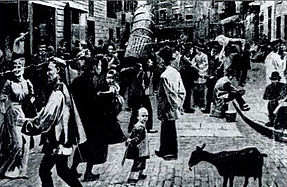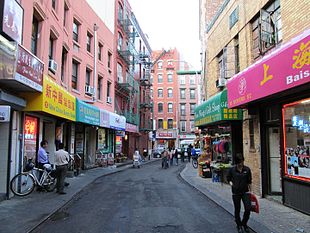Doyers Street
40°42′52″N 73°59′53″W / 40.714354°N 73.998102°W



Doyers Street is a 200-foot-long (61 m) street in the Chinatown neighborhood of Manhattan in New York City. It is one block long with a sharp bend in the middle. The street runs south and then southeast from a terminus at Pell Street to the intersection of Bowery, Chatham Square, and Division Street. Doyers Street contains several restaurants, barber shops, and hair stylists, as well as the Chinatown branch of the United States Postal Service. The Nom Wah Tea Parlor opened at 13 Doyers Street in 1920, and is still in operation; other longstanding business include Ting's Gift Shop at 18 Doyers which opened in 1957.
Etymology
[edit]The street is named for Hendrik Doyers, an 18th-century Dutch immigrant who bought the property facing the Bowery in 1791.[1] He operated a distillery at 6 Doyers Street and the Plough and Harrow tavern near the corner with Bowery.[2][3]
Notable sites
[edit]
Doyers Street follows the old route of a stream.[4] From 1893 to 1911, 5–7 Doyers Street was the site of the first Chinese language theater in New York City. The theater was converted into a rescue mission for the homeless. In 1903, the theater was the site of a fundraiser by the Chinese community for Jewish victims of a massacre in Kishinev.[5]
Nom Wah Tea Parlor, opened in 1920, is the oldest continuously running restaurant in Chinatown.[6] The restaurant first opened at 15 Doyers Street and moved to 13 Doyers in 1968.[7]
Doyers Street, along with Pell Street, contains numerous barber shops and beauty salons.[8][9] The barber shops attract customers, many of whom are Chinese, from as far away as Pennsylvania and Massachusetts.[9] Doyers Street is also home to many speakeasies including Apotheke and Peachy's. [10][11]
Crimes and shootings
[edit]Early in the century, the bend in the street became known as the "Bloody Angle" or "Murder Alley"[12][13] because of numerous killings among the Tong Gangs of Chinatown that lasted into the 1930s.[14] Hatchets were frequently used, leading to the creation of the expression, "hatchet man".[14] In 1994, law enforcement officials said that more people died violently at the "Bloody Angle" than at any other street intersection in the United States.[15] One shooting at the Chinese Theater in 1905 claimed the lives of three people, when members of the Hip Sing Tong fired on members of the On Leong Tong. The shooting took place at a time when the theater was packed with 400 people.[16] In one 1909 incident, two members of the On Leong Tong were shot, one fatally, by members of the rival Four Brothers’ Society, or See Sing Tong. The shooting came after three members of the Hip Sing Tong were executed in Boston for the murder of a member of the On Leong Tong.[17]
A number of old tenement houses are on Doyers Street, and these were sometimes subjected to fires. In 1910, four tenants died and five were injured when fire swept through the building at 15–17 Doyers.[18] In 1939, a fire at the same building, described by The New York Times as "an old rabbit warren," killed seven persons and injured sixteen. Fighting the fire was made difficult because of the narrowness of the street, and Mayor Fiorello La Guardia said at the scene of the fire that someday Chinatown would have to be torn down and replaced.[19] Chuck Connors, a Tammany Hall operative and the political boss of Chinatown in the early part of the century, had his headquarters at the Chatham Club at 6 Doyers,[20] where Irving Berlin reportedly entertained.[21]
Usage
[edit]Writing in H. L. Mencken's American Mercury in 1926, Herbert Asbury pointed out that the street serves no logical purpose, because it is a link between Chatham Square, the Bowery, and Pell Street, which also connects to the Bowery a few feet from Doyers. He called it "a crazy street, and there has never been any excuse for it." He described Doyers Street as the "nerve center" of Chinatown because of the Chinese theater and Bloody Angle.[22] As Doyers and Pell Streets are only accessible from southbound Bowery and traffic from both Bowery and Doyers Street can only continue to southbound Chatham Square, Doyers Street is very lightly used.[23]
By 2011, the street was lined with barbershops, restaurants, a United States Post Office at 6 Doyers Street, and an employment agency at 15-17 Doyers Street that serves recent immigrants of all ethnic backgrounds.[24] As part of a September 2017 pilot program, the Chinatown Partnership converted Doyers Street to a pedestrian-only street during the daytime for one month. If the test is successful, the program would be expanded.[25] The 100 feet (30 m) of the street between Bowery and the Post Office would be available for commercial access.[26] The pavement of Doyers Street was painted in 2021 with Rice Terraces, a 4,800-square-foot (450 m2) mural by Dasic Fernández.[27][28] In September 2021, Chinatown Mural Project created a new tribute mural that honored the memory of beloved photographer Corky Lee on Doyers Street.[29] During the same month, yellow and green lanterns were hung up along Doyers Street as part of the Light Up Chinatown initiative.
References
[edit]Notes
- ^ Jerry E. Patterson, (Museum of the City of New York), The City of New York: a history illustrated from the collections 1978:212.
- ^ Feirstein, Sanna (2001). Naming New York: Manhattan Places & How They Got Their Names. New York: New York University Press. p. 59. ISBN 978-0-8147-2712-6.
- ^ Ostrow, Daniel and Sham, Mary (2008) Manhattan's Chinatown 105ff
- ^ Kimmelman, Michael (December 2, 2020). "Chinatown: Time Travel Through a New York Gem". The New York Times. ISSN 0362-4331. Retrieved December 3, 2020.
- ^ Seligman, Scott D. (February 4, 2011). "The Night New York's Chinese Went Out for Jews". The Jewish Daily Forward. Retrieved February 23, 2011.
- ^ Lohman, Sarah (December 6, 2016). Eight flavors : the untold story of American cuisine (First Simon & Schuster hardcover ed.). New York, London. ISBN 978-1-4767-5395-9. OCLC 944380367.
{{cite book}}: CS1 maint: location missing publisher (link) - ^ Mishan, Ligaya (April 12, 2011). "Nom Wah Tea Parlor". The New York Times. ISSN 0362-4331. Retrieved April 8, 2020.
- ^ Yang, Stephanie (May 7, 2020). "New York's Chinatown Businesses Struggle to Survive Coronavirus Shutdown". Wall Street Journal. Photographs by Alan Chin. ISSN 0099-9660. Retrieved May 24, 2020.
- ^ a b Fam, Mariam (July 6, 2003). "Neighborhood Report: Chinatown; Shave and a Haircut, 200 Miles". The New York Times. ISSN 0362-4331. Retrieved May 24, 2020.
- ^ Kim, Jinny (October 21, 2015). "The 10 Best Speakeasy Bars In New York City". Culture Trip. Retrieved January 21, 2022.
- ^ Dai, Serena (April 26, 2018). "Chinatown's Newest Bar Goes Hard on Superfood Cocktails". Eater NY. Retrieved January 21, 2022.
- ^ Schroeder, Jessa (September 30, 2016). "We unearth the secrets of NYC's 'Murder Alley' - the dangerous streets where notorious gang warfare once lived". nydailynews.com. Retrieved December 3, 2020.
- ^ Bono, Sal (October 26, 2019). "Is the 'Most Violent Street in America' Haunted?". Inside Edition. Retrieved December 3, 2020.
- ^ a b Kifner, John (August 21, 1994). "On Sunday; Benny Ong: A Farewell To All That". The New York Times. p. 45. ISSN 0362-4331. Retrieved October 20, 2010.
- ^ Lii, Jane (June 12, 1994). "Neighborhood Report: Chinatown; On Pell Street, Only Memories Of a Violent Past". The New York Times. ISSN 0362-4331. Retrieved October 20, 2010.
- ^ "Three Shot Dead in Chinese Theater" (PDF). The New York Times. August 7, 1905. ISSN 0362-4331. Retrieved October 20, 2010.
- ^ "Tong War Renewed in Our Chinatown". The New York Times. November 6, 1909. p. 1. ISSN 0362-4331. Retrieved October 20, 2010.
- ^ "Four Meet Death in Chinatown" (PDF). The New York Times. May 30, 1910. ISSN 0362-4331. Retrieved October 20, 2010.
- ^ "7 Dead, 16 Injured in Chinatown Fire" (PDF). The New York Times. June 22, 1939. ISSN 0362-4331. Retrieved October 20, 2010.
- ^ New York City: Vol 1, New York City Guide. Best Books on. 1939. p. 106. ISBN 978-1-62376-055-7.
- ^ Herbert Asbury (July 1, 2008). The Gangs of New York: An Informal History of the Underworld. Vintage Books. p. 293. ISBN 978-0-307-38898-8.
- ^ Asbury, Herbert (1926). "Doyers Street". American Mercury. 8: 118.
- ^ "Doyers St, New York, NY 10013" (Map). Google Maps. Retrieved November 18, 2014.
- ^ Dolnick, Sam (February 22, 2011). "Many Immigrants' Job Search Starts in Chinatown". The New York Times. ISSN 0362-4331. Retrieved February 23, 2011.
- ^ Perler, Elie (September 11, 2017). "Doyers Street Pedestrian Plaza Closes the Angle to Vehicular Traffic for the Next Month". Bowery Boogie. Archived from the original on August 24, 2022. Retrieved September 24, 2017.
- ^ "Community Board 3 Board Meeting Agenda" (PDF). nyc.gov. Manhattan Community Board 3. June 27, 2017. p. 11. Archived from the original (PDF) on September 24, 2017. Retrieved September 24, 2017.
- ^ Pozarycki, Robert (June 27, 2021). "Historic street in Chinatown gets beautiful mural as part of comeback campaign". amNewYork. Retrieved January 21, 2022.
- ^ Weaver, Shaye (June 23, 2021). "See the incredible mural covering an entire Chinatown street right now". Time Out New York. Retrieved January 21, 2022.
- ^ "Corky Lee, activist photographer, is saluted in new Chinatown mural". The Village Sun. September 23, 2021. Retrieved January 21, 2022.
Further reading
- "Manhattan's Chinatown," by Daniel Ostrow, Mary Sham, Arcadia Publishing: 2008
